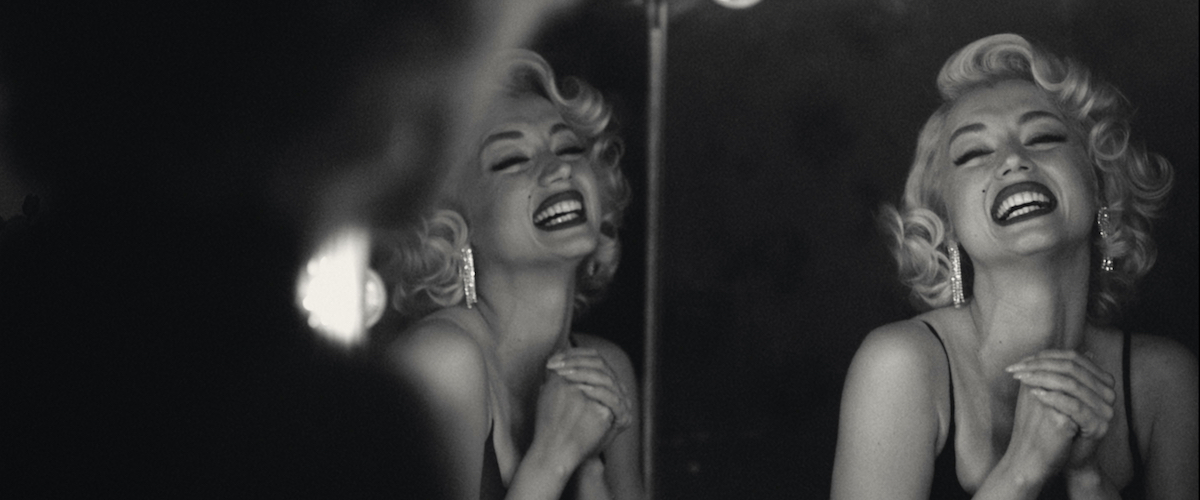In his review for The New Yorker, Richard Brody likens Blonde to Mel Gibson’s The Passion of the Christ. Indeed, while Blonde, directed by Andrew Dominik and released on Netflix last week, is a nearly three-hour figurative crucifixion, it is also a relentless assault on the autonomy of its subject, Marilyn Monroe, as well as a regressive, portrait of her stardom and contribution to American cinema. It is a one-note film, singular of mind and intention, reducing Monroe to an offscreen non-entity, a victim of the Hollywood system used and abused over and over and over again by the industry of her times and Dominik seventy years later. The film is based on Joyce Carol Oates’ eponymous novel and stars Ana de Armas, whose nuanced and galvanizing performance cannot extricate its subject from the director’s sadistic, exploitative clutches and return to her the personhood she is unequivocally denied.
Even from the get-go, young Norma Jeane (who throughout the movie is distinguished from the onscreen persona of Marilyn Monroe she later “adopts”) is denied any complex motivation. The absence of her father, a man her mentally ill mother indicates to her in a framed photograph, is her ostensible guiding star. Her lack of a father colors her relationships with men, from Joe DiMaggio who physically abuses her, Arthur Miller who betrays her trust by using her for creative inspiration, and John F. Kennedy who uses her strictly for sex, to a threesome with Charles Chaplin Jr. and Edward G. Robinson Jr., with whom she shares an emotional bond that the movie severs a third of the way through.
The film takes such a narrow view of Monroe as a person that her arc as a celebrity and creative force is merely hinted at. Rather than credit her foray into modeling, comedic talent, professional determination, and navigation of a heavily male industry, the film is crass enough to attribute her break into Hollywood to being raped by Mr. Z, the president of an entertainment company. This event is representative of the film’s treatment of its subject: regressive and entirely one-sided, a director rinsing its subject through constant trials and tribulations with impunity.
Whether personally or professionally, the film shows Norma Jeane in every compromised position conceivable and constantly mocks and trivializes her struggles. Her desire for a baby is illustrated through conversations she has with not one but three unborn fetuses. Her mother, consigned to a mental institution, only acknowledges her daughter to say she is a disgrace and will never be loved. As she passes away, a holographic image of her elusive father is projected into a starry night sky, in case we forgot what her motivation was. A scene of her performing oral sex on the President of the United States is intercut with images of flying saucers crashing into the Washington monument. The relentless assault on the autonomy she should have earned elicits no pity or empathy, only shame. Norma Jeane is shuttled from one debasement to the next at a relentless pace that seems to be going nowhere fast.
Blonde feels more like a collection of tasteless abuses rather than a cohesive story, illustrating a director who is more comfortable stringing together a series of self-contained scenes (Marilyn stumbling around the house in the dark; Marilyn being raped; Marilyn being told she is unlovable, etc.) than crafting a cohesive story. This is a characteristic of Dominik’s work (I’m thinking primarily of 2012’s Killing Them Softly), and so is the unique style of dialogue that uses a lot of words to say very little. Though Norma Jeane is the focus of the film, her words reveal few inner complexities beyond the superficial.
The only consistent through-line—besides the haphazard editing techniques that distract from the content and seem to exist for no other reason than misguided artistic ambition—is that Marilyn is a depthless character with no purpose but to be the director’s canvas for cinematic flogging. The film insists Norma Jeane was Hollywood’s plaything and awards her zero credit in crafting her onscreen persona, mentions nothing of the production company she founded when the industry put a soft ban on her in the mid-50s, her politics, or her acting chops. The film is regressive in its treatment of a female subject under the handling of a male director’s gaze, reducing its subject to a constantly-crumbling, daddy-obsessed, baby-crazy object to be salaciously ogled and manhandled.
It’s a special kind of directorial sadism that allows such a relentless assault on the autonomy of one of Hollywood’s most fraught yet iconic stars. Stripping its subject of her ability to defend herself, the bravest part of the movie is Ana de Armas’s performance, which embodies Marilyn with an earnest gusto. To quote Norma Jeane’s manager (when asked about her cinematic debut), Blonde is “a stinky piece of crap except for you,” Ms. de Armas.

Comments